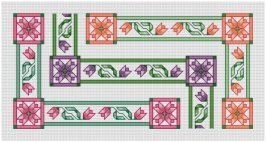Waste Knot, Want Knot?
How to take it and leave it!
Waste knot?
You will often see instructions discouraging the use of knots in cross stitching. Guides usually recommend starting your stitches by burying the thread on the back of the fabric under adjacent stitches.
However, newcomers, children and, on a bad day, I can be easily frustrated by pulling the end completely out when making that first stitch. And what if there are no existing adjacent stitches?
Here's the solution. It will hold the floss in place until you anchor it, then clip it off. Simply the best of both worlds!
Follow this simple guide and you'll never say "no" to knots again!
To make a waste knot
 |
 |
|
1. Thread your needle as usual and tie a knot at the longest tail. |
2. Find where your cross stitch row will begin, then count several stitches to the right of the beginning of your row and insert your needle directly into the middle of a square. Pull the floss until the knot is resting on the front of the fabric. |
 |
 |
|
3. Now insert your needle (from the back to the front) in the lower left corner of what will become your first cross stitch. |
It will appear like this from the back. |
 |
 |
|
Pull the floss all the way through to the top until you take the slack out of the thread. |
The floss should now lay against the back of the fabric. As always, avoid pulling so tightly that the fabric puckers. |
 |
 |
|
4. Complete your first diagonal stitch. |
It should look like this underneath. |
 |
 |
|
5.As you get ready to insert your needle into the lower left corner of the next stitch, turn the fabric over... |
...and make certain that the resulting vertical stitch will overlay the floss from the waste knot. |
 |
 |
|
6. Continue to make your row of diagonal stitches... |
...making sure to overlay the floss each time. |
This is one instance where I recommend that you not use the sewing method initially. It is easier to make certain that your stitches on the back lay OVER the top of the tail from the waste knot.
If you use the sewing method, it's easy to accidentally pierce that tail or go under it. You can return to the sewing method once you've completed these steps.
 |
 |
|
7. When you get to the last stitch before the knot, bring your needle through to the front as though you were starting back to complete the cross stitches. |
8. Turn your fabric over, and you will see a series of vertical stitches over the horizontal tail. You have automatically buried the end! |
 |
 |
|
9. Now remove the knot. Tugging gently, pull the knot away from the fabric... |
...and carefully clip off the knot. |
 |
 |
|
10. Turn your fabric over. If the floss does not automatically recede to the back of the fabric, slip the tip of your needle under the floss near that end and lift it out. Then trim the thread and put a tiny dot of Fray Block where the floss crosses under the last stitch. |
Turn your fabric over and continue to stitch as normal. If you wish, you can complete the cross stitches before clipping away the waste knot. |
This technique will save you some aggravation. Now, you may go for days without pulling your floss out. On the day you do, you will do it ten times! At least that happens to me.
Another way to secure the tread, expecially when you have only one cross by itself (a confetti stitch), is to use the loop start method.
If you have a comment or question about this lesson, or if you would like to suggest a new one, please go to our Contact Us page. (We promise not to use your email address for any other purpose.)
Home › How to Cross Stitch › Waste Knot
